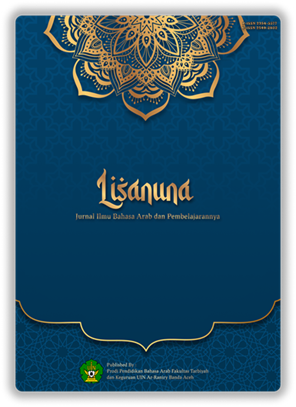مشكلات تدريس اللغة العربية فى المعاهد التقليدية
DOI:
https://doi.org/10.22373/ls.v12i1.13377Keywords:
Al-ma’ahid al-taqlidiyyah, al-Lughah al-‘Arabiyyah, al-Muskilat, al-mu’allimin, al-muta’allimin.Abstract
Bahasa Arab adalah bahasa agama yang berfungsi untuk memahami Al-Qur’an dan sunnah, mempelajarinya adalah fardhu ‘ain dan fardhu kifayah bagi setiap muslim, karena itu bahasa Arab adalah pelajaran wajib di lembaga-lembaga keagamaan, terutama di dayah-dayah tradisional. Karena bahasa Arab bukanlah bahasa lokal, maka dalam peroses belajar mengajarnya dijumpai berbagai problem, baik bagi para santri maupun para para pengajarnya. Problem-problem tersebut diantaranya: 1) karena para gurunya adalah alumni dayah dan tidak dipersiapkan secara khusus untuk mengajar bahasa Arab, sementara para santrinya juga belum pernah belajar bahasa arab sebelumnya, 3) tidak ada kitab khusus bahasa Arab yang diajarkan, yang ada hayalah bahasa Arab dalam kitab-kitab paket (kitab kuning) yang tujuannya hanya sekedar untuk bisa membaca, menterjemah dan memahami kitab-kitab tersebut saja, dan tidak ditujukan untuk bahasa komunikasi dalam kehidupan sehari-hari.
Downloads
References
المراجع
المراجع بالعربية:
الشيخ مصطفى الغلاييني، جامع الدروس العربية، المكتبة العصرية - بيروت، جـ 1.
عبد المنعم سيد عبد العال، طرق تدريس اللغة العربية، دار غريب، القاهرة، دون سنة.
حمد ابراهيم السلوم، تاريخ الحركة التعليمية فى المملكة العربية السعودية – إنترشنال كرافيكس – واشنطون، 1991.
المراجع بالأجنبية:
Departeman Agama RI, Grand Design Pendidikan Keagamaan dan Pondok Pesantren, Jakarta: Departeman Agama, 2004.
Ahmad Patoni, ‘Modernisasi Pendidikan Pesantren’ dalam Akhyak, ed, Meniti Jalan Pendidikan Islam, Yogyakarta: Pustaka Pelajar .
Azyumardi Azra, Pendidikan Islam: Tradisi dan Modernisasi Menuju Milenium Baru, Jakarta, Logos Wacana Ilmu 2000.
Abuddin Nata, Sejarah Pertumbuhan dan Perkembangan Lembaga-Lembaga Pendidikan Islam di Indonesia, Jakarta, Grasindo, 2002.
Jejak-Jejak Pendidikan Islam di Indonesia; Rekontruksi Sejarah Untuk Aksi, Malang: UMM Press, 2006.
Zamakhsyari Dhofier, Tradisi Pesantren: Studi Tentang Pandangan Hidup Kyai, LP3ES, Jakarta 1985, hal. 51.
Downloads
Published
Issue
Section
License
1. Proposed Policy for Journals That Offer Open Access Authors who publish with this journal agree to the following terms:
1.a. Authors retain copyright and grant the journal right of first publication with the work simultaneously licensed under a Creative Commons Attribution License that allows others to share the work with an acknowledgement of the work's authorship and initial publication in this journal.
1.b. Authors are able to enter into separate, additional contractual arrangements for the non-exclusive distribution of the journal's published version of the work (e.g., post it to an institutional repository or publish it in a book), with an acknowledgement of its initial publication in this journal.
1.c. Authors are permitted and encouraged to post their work online (e.g., in institutional repositories or on their website) prior to and during the submission process, as it can lead to productive exchanges, as well as earlier and greater citation of published work (See The Effect of Open Access).
2. Proposed Policy for Journals That Offer Delayed Open Access Authors who publish with this journal agree to the following terms:
2.a. Authors retain copyright and grant the journal right of first publication, with the work [SPECIFY PERIOD OF TIME] after publication simultaneously licensed under a Creative Commons Attribution License that allows others to share the work with an acknowledgement of the work's authorship and initial publication in this journal.
2.b. Authors are able to enter into separate, additional contractual arrangements for the non-exclusive distribution of the journal's published version of the work (e.g., post it to an institutional repository or publish it in a book), with an acknowledgement of its initial publication in this journal.
2.c. Authors are permitted and encouraged to post their work online (e.g., in institutional repositories or on their website) prior to and during the submission process, as it can lead to productive exchanges, as well as earlier and greater citation of published work (See The Effect of Open Access).

